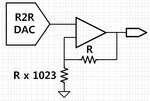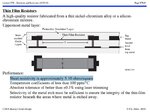020170
Full Member level 4
I tried to design R2R DAC structure at in my circuit.
In my thought R2R DAC is more area effective DAC than conventional R-String DAC.
However, R2R DAC has some disadvantages.
1. VCR Issue
- In CMOS process, poly-silicon resistor or diffusion resistor has voltage coefficient. that is to say, resistor value is dependent for voltage across resistor.
It is not important for R-string DAC because all resistors of R-String DAC has same voltage potential, so VCR does not important.
However, resistors of R2R DAC has different voltage potential, especially it is dependent for digital input code. it caused several INL error issue.
2. LSB Issue( or Not full swing Issue)
- R-String LSB is very simple. for example 10bit DAC, 1 LSB is equal to " VDD / (1023) "
However R2R DAC LSB is equal to " VDD / (1024) "
It means R2R DAC does not output specific analog output, VDD or GND. How can I compensate?
Thanks.
In my thought R2R DAC is more area effective DAC than conventional R-String DAC.
However, R2R DAC has some disadvantages.
1. VCR Issue
- In CMOS process, poly-silicon resistor or diffusion resistor has voltage coefficient. that is to say, resistor value is dependent for voltage across resistor.
It is not important for R-string DAC because all resistors of R-String DAC has same voltage potential, so VCR does not important.
However, resistors of R2R DAC has different voltage potential, especially it is dependent for digital input code. it caused several INL error issue.
2. LSB Issue( or Not full swing Issue)
- R-String LSB is very simple. for example 10bit DAC, 1 LSB is equal to " VDD / (1023) "
However R2R DAC LSB is equal to " VDD / (1024) "
It means R2R DAC does not output specific analog output, VDD or GND. How can I compensate?
Thanks.

